ICBC New Driver Restrictions Snapshot
Class 7 “N” New Driver ICBC License Snapshot
- Drivers must have zero alcohol or drugs in their bodies while driving
- Drivers must clearly display the official ICBC “N” sign on the back of their vehicle
- No hand-held or hands-free electronic devices are permitted while driving
- One passenger only (immediate family exempt) unless with supervisor age 25+ with a valid Class 1, 2, 3, 4, or 5 license
No Electronic Devices
Class 7 ICBC Electronic Device Regulations
- No hand-held cell phones or other electronic devices
- No hands-free cell phones or other electronic devices
- Do not touch, operate, hold, or adjust your phone
- Bluetooth with the wireless headset is not allowed
- Using a speakerphone that can be operated with one touch or voice commands is not allowed
- Do not program a GPS system
- Do not select music from your cellphone
- No earbuds
- Connecting your cellphone or hand-held device to play music on your in-vehicle audio system is not allowed
No Electronic Devices While Driving
- These ICBC N driver restrictions laws apply “while driving.”
- Drivers may safely pull over and park (literally park the vehicle), and then connect music, for example. Just do not touch any of the above while driving.
- These laws are in effect even when you’re stopped at a red light, or stuck in bumper-to-bumper traffic. Technically in those situations, you are not parked; and are “in control of the vehicle.”
- Read more: Use of Electronic Devices, BC Government
Can New Drivers Listen to Music?
- Yes, new drivers may listen to music while driving
- Music devices must be set up before driving and must not be touched while operating the vehicle
- Motor Vehicle Act – Electronic Devices
- British Columbia – Use of Electronic Decides While Driving
New Drivers Must Prominently Display The Official “N” Sign
- The “N” sign needs to be clearly visible
- It is supposed to let drivers know to be a little more patient (or, you know, to stay far away from you)
- If driving a trailer, the “N” sign should be placed on the back of the trailer (not the vehicle). This is where other drivers will be able to see it.
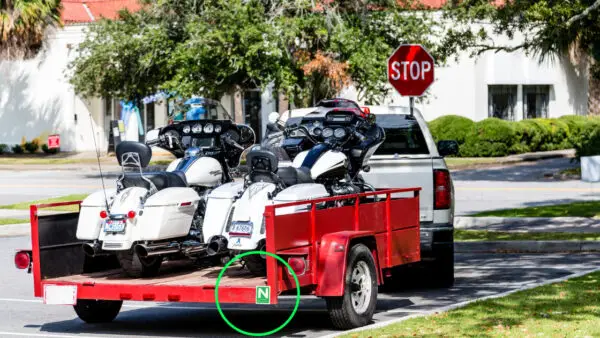
Class 7 “N” License – Zero Drugs & Alcohol
- There is a strict zero alcohol & drug law, including marijuana
- Any drug – legal or not – that may impair driving should be avoided
Can a New Driver Transport Alcohol?
Question: My blood alcohol level would be zero as I would NEVER drink and drive, but some of my family members said that with an N you can get a ticket for even having liquor in your car? I am of legal drinking age.
A New Driver Somewhere
Alcohol Must Be Out of Reach of Driver
New drivers are permitted to transport alcohol as long as it’s sealed and out of reach of the driver and/or passenger compartment, just like drivers of other license classes.
Where to Store Alcohol While Driving?
Store alcohol as far away from the driver/passenger area as possible.
- In the trunk
- Box of pickup truck
- Under the rear seats
- In the very rear of the hatch
- Depending on the type of vehicle
If you check out this ICBC N Driver Restrictions Page it clearly states “You must not drive with any alcohol in your blood,”
Class 7 Licnese – N – Novice Driver Passenger Restrictions
How Many Passengers Can a New Driver Have in BC?
- New drivers (Class 7N) can only take one passenger at this stage unless passengers are immediate family members, or if a supervisor is present
- Vehicles can be filled up with family members as long as each passenger is wearing a seatbelt
- The supervisor must be 25 years or older, with a valid class 1, 2, 3, 4, or 5 driver’s license, and must sit in the front seat
New drivers can only have ONE passenger as per the new driver restrictions… (Immediate family members are exempt)

ICBC Immediate Family Members Definition
What counts as immediate family members? Immediate family means:
- Parents
- Children
- Spouse
- Brothers
- Sisters
- Grandparents
- Step-parent
- Step-grandparent
- Step-child
- Step-brother
- Step-sister
- Foster-parent
- Foster-grandparent
- Foster-child
- Foster-grandchild
- Foster-brother
- Foster-sister
… but not cousins. Cousins are not considered immediate family as per ICBC. Think of cousins as friends.
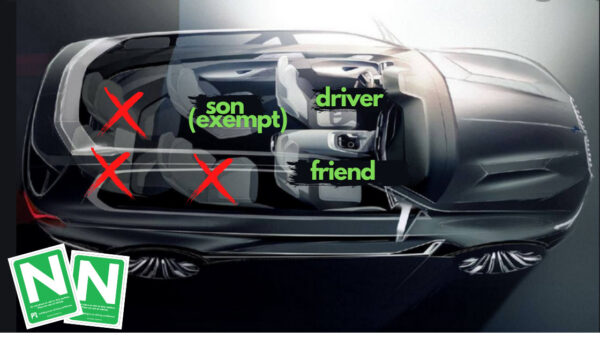
That means you can fill up your car with immediate family members and you can still have one friend (or non-immediate family member)
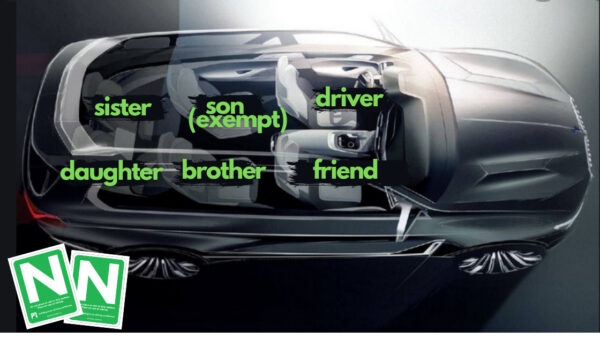
You can also fill up your car with any kind of people if you have a qualified supervisor with a full license class 1, 2, 3, 4, or 5
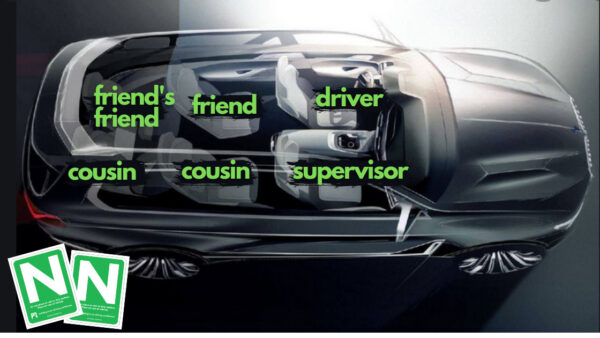
N Driver Passenger Restrictions: Two friends are not permitted
- Friends are nice but have been proven to be very distracting for new drivers
- ICBC has found that new drivers who drive around with friends in their vehicle are much more likely to crash
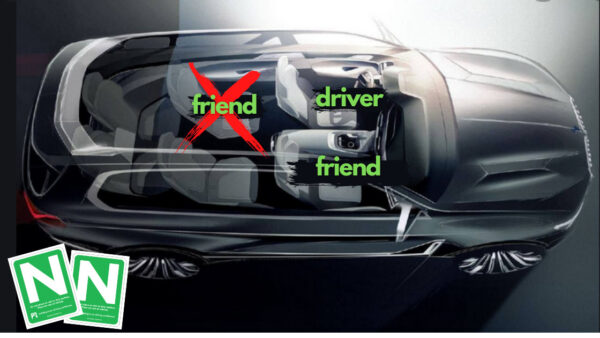
New drivers may not drive with one friend plus another person who is not an immediate family as defined by ICBC above
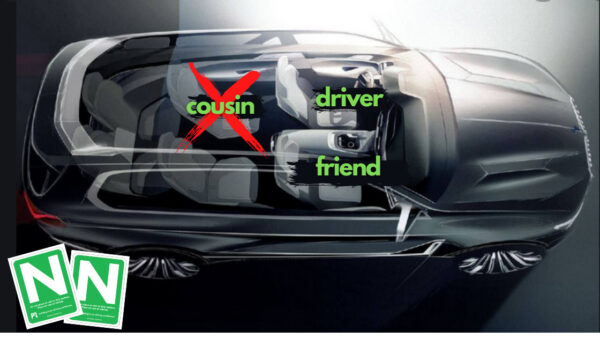
What Vehicles Can New Drivers Operate BC?
Class 7 (7L learner & 7N novice) license holders are allowed to operate all the same vehicles as Class 5 drivers, including passenger vehicles that have 2 axles, such as:
- Cars
- Vans
- Construction & utility vehicles (2 axle maximum)
- Light trucks
- Limited-speed motorcycles or ATVs (all-terrain vehicles)
- Any motor home – including those exceeding 2 axles – not equipped with air brakes
- 3-wheeled vehicles; does not include 3-wheeled motorcycles (trikes) or motorcycle/sidecar combinations
Can A New Driver Tow A Trailer?
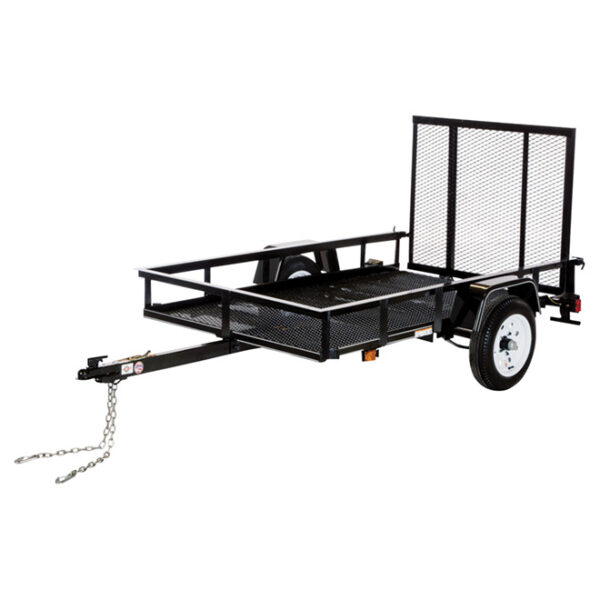
New drivers and learner drivers in BC (Class 7 L & N) are allowed to tow a trailer that weighs up to a maximum of 4,600 kg GVW (gross vehicle weight CVSE Ministry of Transportation) GVW is the combined weight of your trailer and its load.
Watch your weight
Just be careful, because after you load the trailer, the GVW might exceed 4,600 kg. So do watch your weight especially if you’re packing your collection of designer marble countertops, a collection of pianos, or something like that.
Can A New Driver Rent A U-Haul in British Columbia?
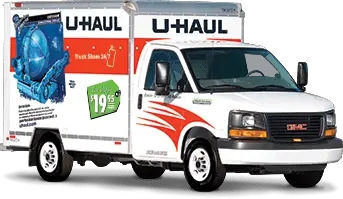
- Yes, Class 7Ns may drive U-Hauls
- U-Haul requires that renters be at least 16 years old to rent a trailer
- Drivers must be at least 18 years old to rent trucks
- Special driver’s licenses are not required to rent a U-Haul, since they are not classified as commercial vehicles
Any license which grants the ability to drive without supervision will work. Learners’ permits are not acceptable.
U-HAUL
Can Your Supervisor be Drunk?
So, in addition to zero blood alcohol for the new driver, the supervisor needs to have a BAC under 50 mg% (.05). Ideally, the supervisor should have a zero blood alcohol requirement too.
Alcohol and the Learner Driver Supervisor – DriveSmart BC
Can New & Learner Drivers Drive In the U.S. & Across Canada?
Generally speaking, yes, the N driver restrictions allow for both N and L to drive across Canada & in the U.S. Just make sure to follow the same restrictions displayed on the back of your license. You might need a magnifying glass to read it.
Check with individual destinations to learn about location-specific requirements. Look into changing your car’s speedometer to miles – used in the U.S. 50 km/hr is roughly equal to 31 mph. 80 km/hr is about 50 mph.

When in Rome… I mean, when in the USA, do as the Canadians do. If you do get pulled over, authorities will look at your license. They will be able to see your restrictions. And, they’ll expect you’re following the rules.
Driving On The Highway/Freeway with Class 7
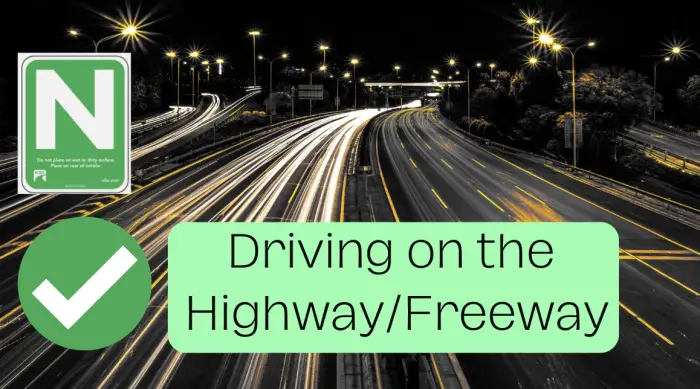
Can Class 7 Drive On Highway In BC?
Yes, you can drive on the highway & freeway with your Learner’s license and New driver’s license (Class 7L & 7N). The only exception is if it indicates you aren’t allowed on the back of your license. This is rare and usually in response to an incident. The only way to get better at driving is to practice driving. This includes driving on the highways and freeways.
Spouse Definition For ICBC Restrictions
What counts as a spouse?
A spouse is defined as someone who was married to another person at “the relevant time” or who was living for a minimum of 2 years or longer immediately before the “relevant time” in a marriage-like relationship. This includes marriage-like relationships between people of the same gender identity.
Length Of Time In ‘N’ Stage
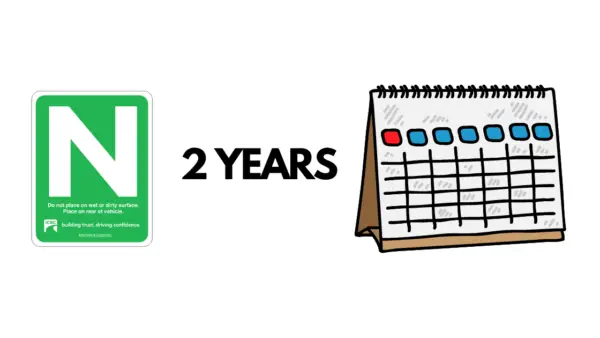
Part of the N driver restrictions includes a mandatory amount of time in this stage.
- This stage must last for at least 24 months (2 years) unless you have successfully completed a GLP driver education program
- N licenses won’t expire for 5 years
- In the case you’ve completed an approved driver’s education program, your 24 months can be reduced to 18 months
- If your license is suspended, cancelled, expired, or surrendered, you must wait longer to qualify for a fully privileged driver’s license
- Once your license is reinstated, your 24 months will start over from the beginning
Can You Renew Your N License BC?
How long do you have your N for in BC?
Even though you can take your second road test after two years, your 7N Novice license won’t expire for five years. After five years, if you’re still not ready for the second road test, you can simply renew your driver’s license, just like anyone else. You’ll just need to go to ICBC, pay a fee, and get a new photo taken.
The only thing to be aware of is the amount of time your “N” license has expired. If it’s expired for a long time (don’t quote me but I believe it is 2 or 3 years), then you won’t be able to simply renew it.
At that point you’ll need to do another road test, or, you can also just get a BC-ID card which is a non-driver photo ID if you’re not into driving anymore.
How to Get Your N in 6 Months?
Drivers can no longer get the N in 6 months. If you successfully complete an ICBC-approved GLP driver education course, then you’ll be able to get 6 months taken off your total N time; a grand total of 18 months driving with the Class 7N license rather than 24 months.
Time Of Day Restrictions
Can N Drivers Drive At Night In BC?
Yes, Class 7N new drivers can drive at night or anytime 24/7/365. There are no time restrictions – you may drive whenever you like, as long as you’re following all of the restrictions printed on the back of your license.
The only time restriction is in the “L” Phase. Do be careful driving in the middle of the night. It may seem easier because there’s no rush hour, but drivers can sometimes be more dangerous; unfortunately, there may be impaired drivers on the roads.
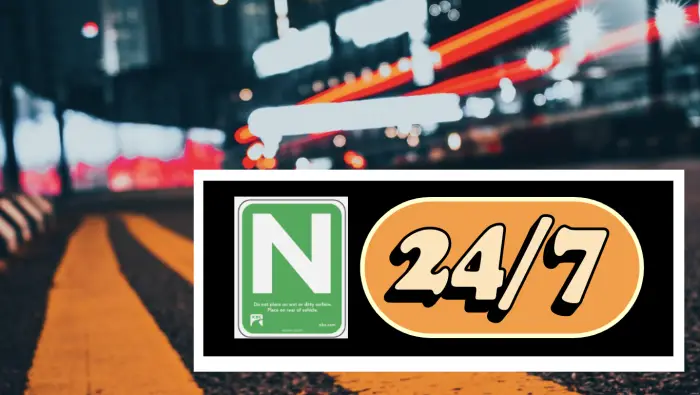
Can a New Driver Drive With a Baby in British Columbia?
Yes, babies are sons and/or daughters; so they count as immediate family members.
Just be sure to follow your passenger restrictions. Immediate family members are exempt from the one-passenger restriction in the “N” stage.
In other words, daughters and sons are allowed. The safest place for a car seat is in the rear, or middle seat, as it is farthest away from potential airbags and impact.
Lost Your L or N Sign?
ICBC N & L Signs
If you lost your L or N sign, you have a few options. You could:
- Download and print this N sign right here
- Download and print this L sign here
- Make sure to attach it to your vehicle so that it’s clearly visible
- Unfortunately, making your own creative sign is not permitted
- Otherwise, you will need to visit ICBC. Check ahead of time as many locations are only allowing appointments and no walk-ins
Question: Is It Illegal To Keep An “N” Or “L” On The Back Of A Vehicle All The Time Even If The Driver Is Not In The Learners Or New Category?
Answer From The VPD (Vancouver Police Department) Via Email:
The simple answer is “ no “it is not illegal, but keep in mind that you may be stopped if you are the lone occupant of the vehicle driving while displaying an “L” sign. The “L” sign requires the driver to be accompanied by a qualified supervisor. If an officer sees a vehicle operated by a lone individual while displaying an “L” sign the officer will more than likely stop the vehicle to ascertain if he/she is contravening the licence restrictions.
Can An N Driver Drive My Car?
Yes, new and learner drivers can drive your car, but ICBC asks you to list who drives your car. Examples are family members and employees – including learner drivers and new drivers. In September 2019, ICBC changed its insurance model. It’s moving to a more driver-based system.
You can add a learner or a new driver to your listed drivers at an Autoplan broker office. You will need their driver’s license number and birthday. You can add or remove listed drivers anytime.
If an unlisted driver crashes your car, you could face financial consequences unless you have Unlisted Driver Protection. I also wrote a comprehensive article on how ICBC claims work if you want to find out more about that.
Driver-based model: Under the new model, at-fault crashes will follow the driver, not the vehicle. However, crashes caused by learners won’t go on their ICBC driving record. The learner stage will also not count toward their driving experience. Read more: ICBC – For parents of teen drivers.
Common ICBC Restriction Codes
BC Drivers License Restriction Examples
Wondering what those numbers on your license mean? Here are some common ICBC restriction codes.
- Restriction 14 – Restriction 14 may be applied to a license due to a road test. Drivers with this restriction are not permitted to operate a vehicle on Highway 99 south of Vancouver, Highway 1 east of Vancouver, or west of Highway 9.
- Restriction 21 – Corrective lenses required
- Restriction 39 – Qualified supervisor required age 25+, 1 passenger
- Restriction 43 – 5 am to midnight only L
- Restriction 45 – 1 passenger unless supervisor aged 25+, family exempt
- Restriction 46 – 0 BAC/BDC (blood alcohol/drug content), must display L sign, no electronic device
- Restriction 47 – 0 BAC/BDC (blood alcohol/drug content), must display N sign, no electronic device
Driving Without Consideration
Random Question : Hi there. I recently got in a bad collision and was given a ticket for “driving without consideration”. This is the only ticket I got – does it affect my N permit?
It looks to be a $196 Ticket worth 6 points. Normally the new driver’s record will be automatically reviewed by the superintendent after 3 or more points. So, it does seem likely you may be headed toward a prohibition of 1-6 months.
Question on Overloading With N:
Does driving with more than one passenger on an N license void your insurance?
Answer: No it does not void your insurance.
ICBC FAQ:
{Say my son drives with an N and violates the “one passenger rule,” would he still be covered if he had an accident and the passengers were injured? What about the cost of damage to vehicles involved?
Unfortunately, young drivers are inexperienced and more likely to crash—which is why the “one passenger rule” is in place.If this situation were to happen though, your son will still be covered by insurance. However, he’d likely get a ticket or have his licence suspended for breaking the rules of the graduated licensing program. The rules of the program are in place to keep young drivers as safe as possible while they’re inexperienced.}
ICBC
Conclusion
These new driver restrictions can seem downright annoying. But of course, they are there to try and keep people safe. New drivers are simply at increased risk of crashing and causing injuries. This is due to many factors; two of the most important being driver inexperience, and driver distraction, and sometimes you can throw raging hormones and some other stuff into the mix there, too.
Apparently, The brain does not fully develop until the age of 25. That’s probably not what you want me to tell you. The part of the brain that doesn’t develop until age 25 is called the prefrontal cortex.
Impulsive behaviours may be much more tempting up until the age of 25. This is why it’s not a coincidence that many car rental companies charge a “youthful surcharge” or have an additional fee for those under 25.
They aren’t simply hating on your age; those under 25 statistically crash automobiles more, take more risks and get into accidents in general.
No one says you have to learn how to drive at any certain age (I mean, maybe they do..), but just learn when you feel ready.
My recommendation would be to follow the rules and avoid getting any tickets. Get through the graduated licensing program as efficiently as you can.
Even though it may not seem like it, there is a fully privileged driver’s license waiting at the end of it all. And I think the marvellous newfound freedom that comes with that will all be worth it.
If you have problems saying “no” to your friends, it may be helpful to drive a car that only has 2 seats such as the following… not that this is necessarily a practical, affordable or desirable option, but still maybe something to think about.
- Honda CR-Z
- Mazda MX-5 Miata
- Nissan 370Z
- Smart Fortwo
- BMW Z4
- TT Roadster
Staying out of trouble in this phase is important, and one way to help prevent collisions is in parking lots, where collisions commonly occur (#2 most common place for collisions, after intersections). You can help prevent trouble by reversing into your parking space so that you don’t need to reverse out and learning about Right-of-Way in the Parking Lot. Also, read up on defensive driving strategies to prevent collisions to stay safe while driving.
Related Articles:
- ICBC L Driver Restrictions
- What is the Graduated Licensing Program?
- How Long Does it Take to Learn How to Drive?
Carmen Cohoe
Carmen became a driving instructor in beautiful North Vancouver at the age of 22 due to some crazy people who agreed to hire her. After that, there was never a dull moment teaching many different folks from many different places how to drive using automatic and standard vehicles and a minivan.

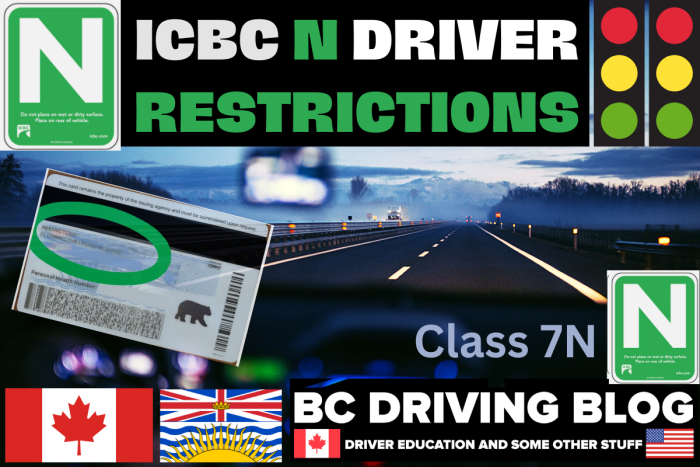

Can a novice driver drive with full passenger (not immediate family) with a supervisor that has international license equivalent to class 5?
If I have my N license can I drive on public off roads?
You can drive on any road that everyone else is allowed to drive on unless it has a restriction on the back of your license
Can a novice driver drive with adults, over 25 years of age, not related, with valid BCDL, if the passengers have consumed alchohol?
What do you think?
why do you think they’re asking? would they ask if they knew?
A drunk supervisor would defeat the purpose of having a supervisor and I think that is common sense…
If i have had my N for more than 24 month, but a clean driving record, how long can i keep my N without taking the class 5 road test before it expires?
If you’re not ready for the class 5 road test you can simply go to ICBC and renew your N license ..
if you leave the N expired for a while then it gets more complicated, I forget but I’ll look it up
Hi again, Your license will let you know the date of expiry on the license itself. After that, you can simply renew the N at ICBC. If you do not renew it, I’m not sure how long you can keep it around before you would have to do another road test. Hope that made sense!
My son has had his N for over 24 mouths in those 24 mouths he had a good driving recorded. he’s got crapy luck got two speeding tickets one 5 over passed his 24 mouths but still had N. paid one ticket booked his class 5 test When to do test had to pay the other ticket before he could write test payed then took test passed got his class 5. July 3 gets a letter in mail on July 18 notice of intent to prohibit. For 4 mouths and cancel his license. That he will have to replay for.